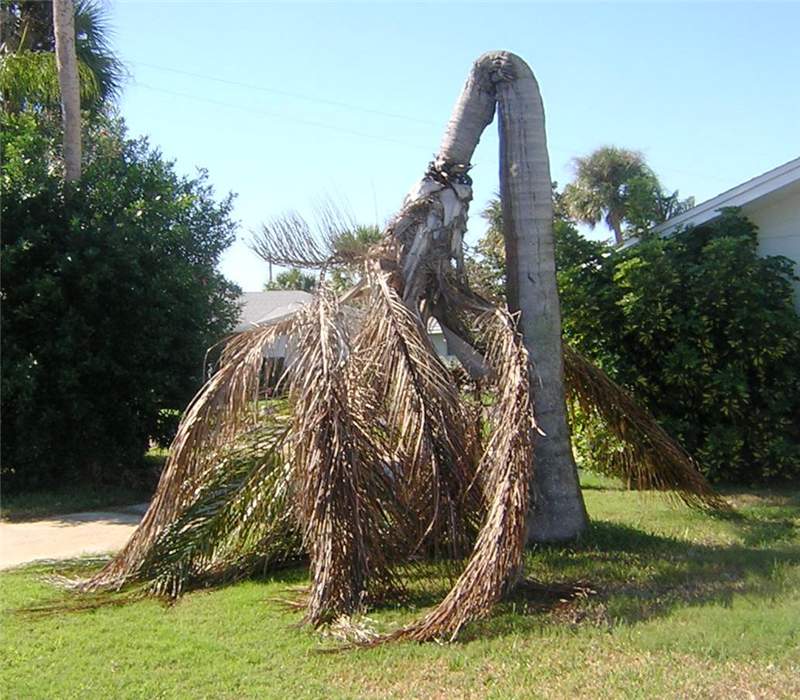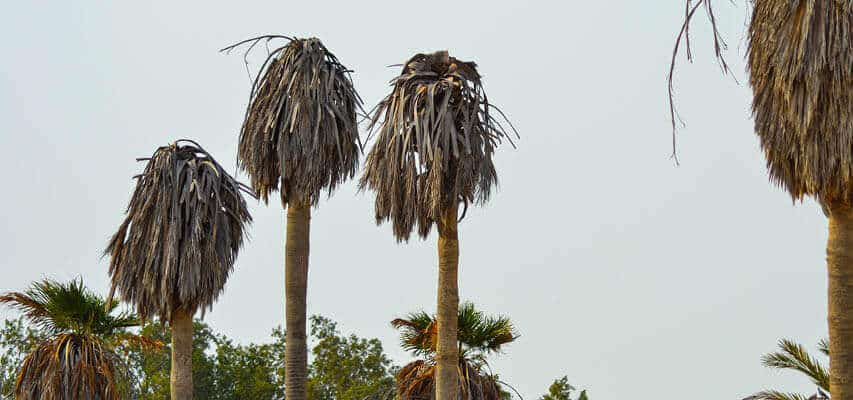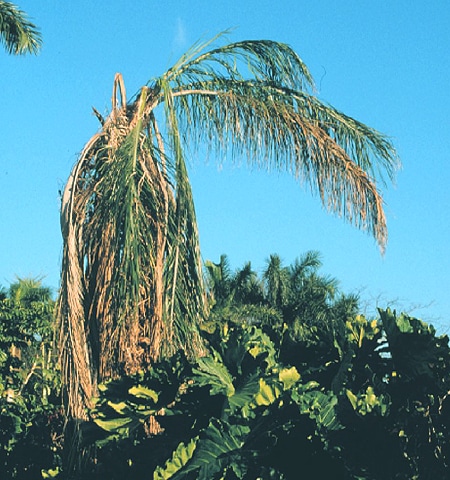Understanding Palm Bronzing Disease
Palm Bronzing Disease, a condition that has increasingly become a concern for gardeners, homeowners, and agricultural professionals, manifests as a noticeable discoloration and weakening of palm trees. This disease not only affects the aesthetic appeal of these majestic plants but also their health and longevity. Understanding the nature of Palm Bronzing Disease is the first step towards effectively managing and preventing its spread.
At its core, Palm Bronzing Disease is characterized by a gradual change in the color of palm leaves, moving from their vibrant green to a dull, bronze-like hue. This discoloration is often the first sign that a palm tree is under stress or attack from pathogens. The disease can affect a wide range of palm species, making it a widespread issue in regions where palms are prevalent. The bronzing of the leaves is not merely a cosmetic issue; it indicates a deeper problem that could potentially lead to the decline and eventual death of the palm if not addressed promptly.
The importance of recognizing and understanding this disease cannot be overstated. Early detection and intervention can make a significant difference in the outcome for affected palms. By familiarizing themselves with the symptoms and causes of Palm Bronzing Disease, palm tree caretakers can take proactive steps to protect these valuable plants. Whether you are a seasoned arborist or a homeowner with a few palm trees in your garden, gaining an understanding of Palm Bronzing Disease is essential for ensuring the health and beauty of these iconic trees.
Identifying the Symptoms of Palm Bronzing
Identifying the symptoms of palm bronzing is crucial for early detection and effective management of the disease. The most noticeable sign of palm bronzing disease is the discoloration of the palm leaves, which typically manifests as a bronze or brownish tint, deviating from the healthy green color. This discoloration often starts at the tips of the leaves and gradually spreads towards the base, affecting the overall vitality and aesthetic appeal of the palm.
Another symptom to watch out for is the presence of spots or patches on the leaves. These spots may vary in color from yellow to dark brown and are usually surrounded by a halo of lighter discoloration. In severe cases, the affected leaves may become brittle, leading to breakage or complete leaf loss, which can significantly impact the palm’s ability to photosynthesize and maintain its health.
Stunted growth is also a common symptom associated with palm bronzing. Palms affected by this disease may exhibit slower growth rates compared to healthy palms. This can be particularly detrimental for young palms that are still in their formative years. Additionally, the fronds of the palm may appear wilted or droopy, indicating a lack of vigor and vitality.
It’s important to note that symptoms of bronzing in palms can be similar to those caused by other diseases or nutritional deficiencies. Therefore, accurate diagnosis is essential for implementing the correct treatment strategy. Observing the symptoms closely and consulting with a professional arborist or palm tree care specialist can help in correctly identifying palm bronzing disease and taking timely action to mitigate its effects.

The Causes Behind Palm Bronzing Disease
Palm Bronzing Disease, a condition that leads to the discoloration and weakening of palm trees, is primarily caused by a combination of factors rather than a single pathogen. Understanding these causes is crucial for effective management and prevention of the disease. One of the primary culprits behind palm bronzing is nutritional deficiency. Palms require a balanced diet of essential nutrients, including nitrogen, potassium, magnesium, and iron. A deficiency in any of these can lead to the characteristic bronzing or yellowing of the leaves, starting from the tips and margins and eventually affecting the entire leaf.
Another significant factor is the presence of pests and diseases. Certain pests, such as spider mites and palm leaf beetles, can cause damage that mimics the symptoms of nutritional deficiencies, leading to bronzing. Similarly, fungal infections like Fusarium and Ganoderma can weaken the palm, making it more susceptible to environmental stresses and nutrient uptake issues.
Environmental stress is also a contributing factor to Palm Bronzing Disease. Extreme weather conditions, such as prolonged drought or excessive rainfall, can stress palms and affect their ability to absorb nutrients properly. Poor soil conditions, including high salinity, compaction, and improper pH levels, can further exacerbate nutrient uptake problems, leading to the development of bronzing symptoms.
Lastly, improper cultural practices, such as over-pruning, incorrect fertilization, or inadequate watering, can weaken palms and make them more susceptible to diseases and pests. Understanding these causes is the first step towards effective prevention and treatment of Palm Bronzing Disease, ensuring the health and longevity of palm trees.
The Impact of Environmental Factors on Palm Health
Environmental factors play a significant role in the health and well-being of palm trees, influencing the onset and severity of palm bronzing disease. Understanding these factors is crucial for effective palm tree care and prevention of diseases. One of the primary environmental contributors to palm bronzing is inadequate sunlight. Palms that are planted in areas receiving insufficient sunlight are more susceptible to stress, which can exacerbate the symptoms of bronzing in palms. Similarly, water stress, whether due to overwatering or drought, can weaken palm trees and make them more vulnerable to diseases, including bronzing.
Soil quality and nutrition also significantly impact palm health. Poor soil conditions, such as compacted soil or incorrect pH levels, can restrict root growth and limit the uptake of essential nutrients. This nutritional deficiency can lead to palm leaf discoloration, including the bronzing effect. Additionally, exposure to extreme temperatures, both hot and cold, can stress palm trees and contribute to the development of bronzing symptoms.
Preventing palm bronzing requires a comprehensive understanding of these environmental factors and their management. Ensuring that palm trees are planted in well-draining soil, receive adequate water and sunlight, and are protected from extreme temperatures can help mitigate the risk of palm bronzing disease. Regular soil testing and appropriate fertilization can also address nutritional deficiencies, promoting healthier palms less prone to disease. By recognizing the critical role of environmental conditions in palm health, gardeners and homeowners can take proactive steps in preventing palm bronzing and maintaining vibrant, healthy palm trees.

How to Diagnose Palm Bronzing Disease
Diagnosing Palm Bronzing Disease requires a keen eye and an understanding of the symptoms that distinguish this condition from other palm tree ailments. The first step in diagnosis is a thorough examination of the palm’s physical appearance. Look for the characteristic signs of bronzing, such as a dull, grayish-brown discoloration on the leaves, which often starts at the tips and edges before spreading inward. This discoloration is a key indicator of the disease and differs from the yellowing associated with nutrient deficiencies.
Another critical aspect of diagnosis involves assessing the pattern and progression of symptoms. Palm Bronzing Disease typically affects the older leaves first, gradually moving to the younger foliage as the condition worsens. This pattern is distinct from some other diseases and pests that might start affecting the palm from the top or uniformly across all leaves. Observing the progression can help confirm a diagnosis of Palm Bronzing Disease.
It’s also important to consider environmental factors and recent care practices, as these can provide clues to the disease’s presence. For instance, palms that have been exposed to excessive water or poor drainage conditions are more susceptible to developing bronzing. Similarly, a history of improper fertilization or exposure to herbicides could contribute to the symptoms observed.
For a definitive diagnosis, it may be necessary to consult with a professional arborist or a plant pathologist. These experts can perform more sophisticated tests, such as soil analysis and leaf tissue sampling, to confirm the presence of Palm Bronzing Disease. They can also rule out other potential causes of the symptoms, ensuring that the treatment plan is appropriately targeted to the problem at hand.
Understanding the diagnostic process for Palm Bronzing Disease is crucial for timely and effective management of the condition. By recognizing the symptoms and patterns of this disease, palm tree owners can take the first step towards restoring the health and beauty of their palms.
Preventative Measures for Palm Bronzing
Preventing palm bronzing disease begins with understanding the specific needs and vulnerabilities of palm trees. Proper care and maintenance are crucial in keeping palms healthy and more resistant to diseases, including bronzing. One of the first steps in prevention is ensuring that palms are planted in well-draining soil to avoid waterlogging, which can stress the tree and make it more susceptible to diseases. Additionally, it’s important to water palms appropriately; too much or too little water can both be harmful.
Another key aspect of preventing palm bronzing is the careful monitoring and management of nutrient intake. Palms require a balanced diet of nutrients, and deficiencies in essential minerals like magnesium and potassium can lead to symptoms similar to bronzing. Regularly applying a palm-specific fertilizer can help maintain the necessary nutrient levels and prevent deficiencies.
Pruning is also a critical preventive measure. Removing dead or dying fronds can help improve air circulation around the palm, reducing the humidity and moisture that can foster fungal growth. However, it’s important to prune palms correctly, as improper cuts can create entry points for pathogens.
Monitoring for pests and diseases is another essential preventive strategy. Early detection of issues allows for quicker intervention, potentially preventing the spread of disease. Implementing integrated pest management (IPM) strategies can help manage pests without relying solely on chemical treatments, which can sometimes harm beneficial organisms or lead to resistance.
Finally, selecting the right palm species for the local climate and environment can significantly reduce the risk of palm bronzing. Some palm species are more resistant to certain diseases and pests, so choosing a species that is well-suited to the area’s conditions can lead to healthier, more resilient palms.

Treatment Options for Affected Palms
Treating palm bronzing disease begins with a proper diagnosis to ensure the correct approach is applied. Once the presence of palm bronzing is confirmed, treatment options can vary based on the severity and underlying cause of the disease. For nutritional deficiencies, which are a common cause, the application of appropriate fertilizers that are rich in essential nutrients like magnesium and potassium can help reverse the symptoms. It’s crucial to follow a balanced fertilization regimen to avoid further stressing the palm.
In cases where the bronzing is due to pest infestations, such as spider mites or scale insects, targeted treatments with insecticides or natural predators can be effective. Always opt for the least toxic option first to minimize harm to the palm and the surrounding environment. For fungal infections, fungicides may be required, but it’s important to apply them judiciously and according to the manufacturer’s instructions to avoid resistance buildup and protect beneficial organisms.
Improving the palm’s growing conditions can also significantly aid in recovery. Ensuring proper soil drainage, adequate water (but not overwatering), and sufficient sunlight are foundational steps in creating a healthy environment for palms. In some cases, pruning of severely affected or dead fronds can help reduce the spread of disease and improve the aesthetic appearance of the palm, but it should be done carefully to avoid further stress.
For severe cases or when in doubt, consulting with a professional arborist or a plant disease specialist is advisable. They can offer more specific insights and treatments, including advanced options like soil injections or trunk treatments that might not be readily available to the general public.
Prevention remains the best treatment. Regular monitoring for early signs of distress, maintaining a proper care schedule, and implementing preventative measures can keep palm bronzing disease at bay, ensuring the health and beauty of your palms for years to come.
The Role of Professional Arborists in Managing Palm Diseases
Professional arborists play a crucial role in the management and treatment of palm diseases, including palm bronzing. These experts possess a deep understanding of tree biology, pathology, and the specific care requirements of various palm species. Arborists are trained to identify the subtle signs of palm diseases early on, which is essential for preventing the spread of the disease and minimizing damage.
When it comes to palm bronzing disease, arborists can provide invaluable services such as accurate diagnosis, which often involves laboratory testing of soil and plant tissue samples. They are knowledgeable about the environmental factors and pathogens that contribute to the disease, enabling them to recommend effective treatment plans tailored to the specific needs of the affected palms.
Moreover, professional arborists can advise on the best preventative measures to protect palms from bronzing and other diseases. This may include recommendations on proper irrigation practices, soil management, fertilization, and pruning techniques that help improve the overall health and resilience of palm trees. Arborists also guide on the selection of disease-resistant palm varieties for new plantings, significantly reducing the risk of future outbreaks.
In cases where palm bronzing disease has already taken hold, arborists can implement treatment options that may include the application of fungicides, insecticides, or other treatments designed to target the underlying cause of the disease. They can also perform necessary pruning or removal of severely affected palms to prevent the disease from spreading to healthy trees.
Engaging the services of a professional arborist is an investment in the health and longevity of palm trees. Their expertise not only helps in managing palm bronzing disease but also contributes to the overall aesthetic and value of landscapes.
Long-Term Care Strategies for Healthy Palms
Maintaining the health of palm trees over the long term requires a comprehensive approach that addresses both preventive care and active management of any issues that arise. To ensure the vitality and longevity of your palms, it’s crucial to implement a series of care strategies that not only protect against palm bronzing disease but also bolster the overall resilience of these plants. First and foremost, regular monitoring of palm health is essential. This involves inspecting the palms for any signs of distress or disease, such as symptoms of bronzing in palms, which could indicate the onset of palm bronzing disease or other ailments.
Watering practices play a pivotal role in palm tree care. Palms should be watered deeply but infrequently, allowing the soil to dry out somewhat between watering sessions. This helps prevent root rot and other moisture-related diseases. Additionally, ensuring proper drainage is critical to avoid waterlogging, which can stress the palm and make it more susceptible to diseases.
Nutrition is another key aspect of long-term palm care. Utilizing a balanced, slow-release fertilizer that is specifically formulated for palms can provide them with the essential nutrients they need to thrive. It’s important to follow the recommended application rates and schedules to avoid nutrient imbalances that can lead to palm leaf discoloration and other health issues.
Pruning is also beneficial for maintaining palm health. Removing dead or dying fronds can help prevent the spread of disease and reduce the likelihood of pest infestations. However, it’s crucial to prune palms correctly, as improper pruning can cause unnecessary stress and damage to the tree.
Finally, implementing preventative measures against palm bronzing and other diseases is essential. This may include selecting disease-resistant palm varieties, ensuring proper spacing between trees to improve air circulation, and applying appropriate fungicides or insecticides as preventive treatments. By adopting these long-term care strategies, you can help ensure that your palms remain healthy and vibrant for years to come.
Case Studies: Recovery from Palm Bronzing Disease
The journey to recovery for palms affected by bronzing disease is both challenging and enlightening. Through various case studies, we’ve observed that early detection and appropriate response are crucial to managing and reversing the effects of this condition. One notable case involved a homeowner in Florida, where palm trees are a common sight. The homeowner noticed the early symptoms of bronzing, such as slight discoloration and reduced vigor in their palm. By consulting with a professional arborist and implementing a tailored treatment plan, which included nutritional supplements and careful pruning, the palm showed significant improvement within a year.
Another case study from California highlights the importance of environmental management in preventing palm bronzing. A community garden experienced a widespread outbreak of the disease, largely attributed to poor soil conditions and inadequate irrigation practices. By addressing these environmental factors, alongside the application of specific fungicides recommended by experts, the garden was able to halt the spread of the disease and gradually restore the health of its palm trees.
These case studies underscore the effectiveness of a comprehensive approach to dealing with palm bronzing disease. From the initial diagnosis to the application of treatments and long-term care strategies, each step plays a vital role in the recovery process. Moreover, they emphasize the value of professional advice and intervention. Arborists and plant health care specialists possess the knowledge and tools necessary to combat palm diseases effectively, making their involvement indispensable in both preventive measures and treatment efforts.
Ultimately, the battle against palm bronzing disease is winnable. With informed action, ongoing care, and the support of professionals, palm owners can protect their trees from the ravages of this condition and ensure their longevity and beauty for years to come.
